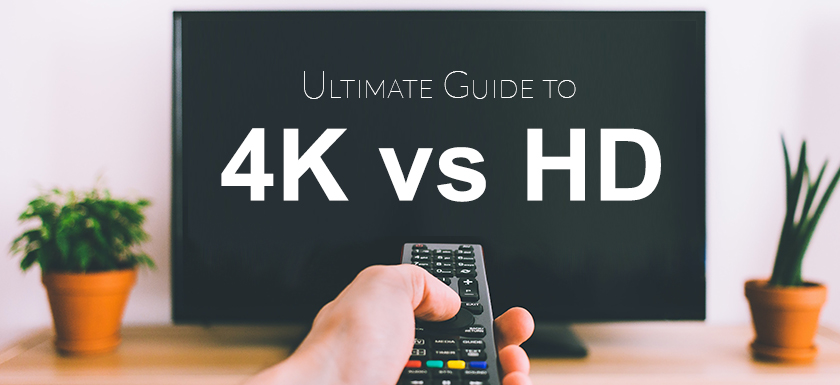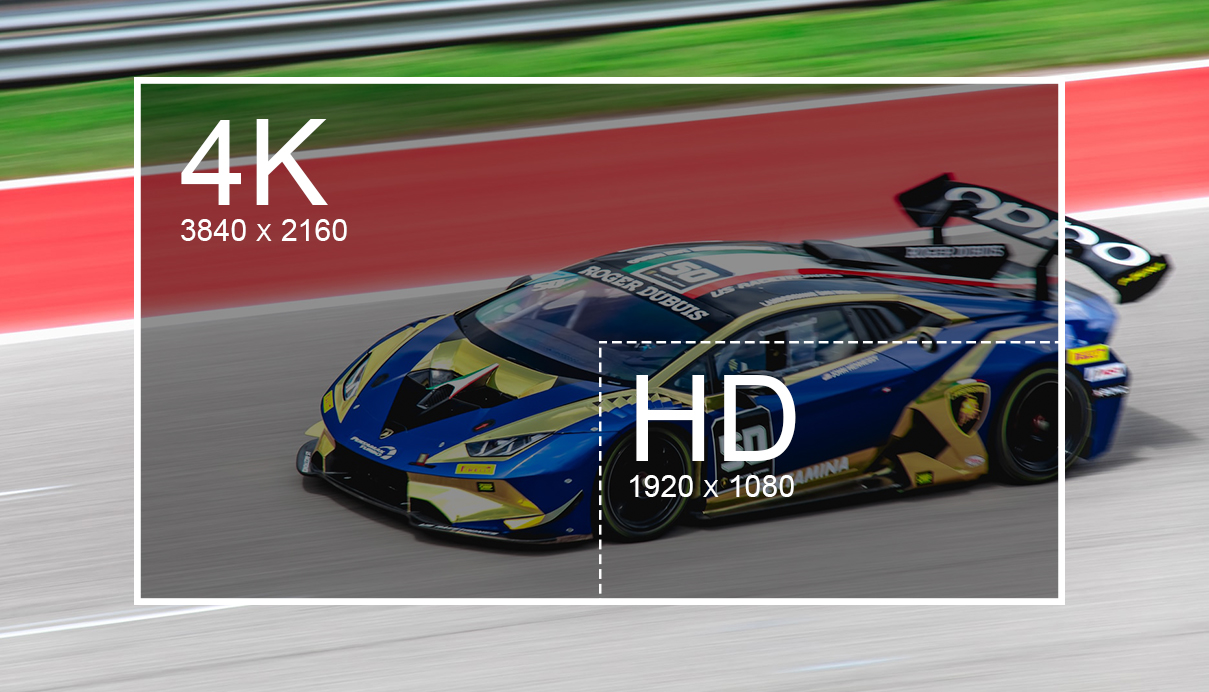
What’s considered the “latest” technology today, can easily become outdated tomorrow.
Remember the days of SD? Well, those days are long gone, and we’ve gone from HD resolution to Full and Ultra HD and 4K…to the all-new 8K waiting to takeover.
With everything moving so fast, all these different abbreviations can often cause confusion, making it even more perplexing to decide which technology is right for your needs.
Before, we start to take a look at the key differences between a 4K vs HD TV, let’s cover our bases by understanding video resolution and pixels.
What is video resolution?
Video resolution is the number or count of pixels that make up a frame in a video.
A pixel is the smallest element of a digital image. It is one of the small dots (sort of like an atom) which is a part of millions of other dots that make up the picture in a video. The more pixels an image has, the higher the video resolution and the crisper the video frame appears.
In the image below, you can see that as you zoom in the individual pixels of a part of the image are visible:
![]()
4K vs HD TV resolution comparison
(8,294,400 pixels vs. 2,073,600 pixels)
When you hear of resolution, you’ll often hear of 480p, or 720p, or 1080p. These don’t refer to the number of pixels in total in an image, but rather the pixels in the height of an image.
So, for example, a 1080p high-definition or HD image is actual 1080 pixels in height and 1920 pixels in width (16:9 aspect ratio) — the total number of pixels in total is 2,073,600 pixels.
4K is 4x more pixels than HD — the total number of pixels being 8,294,400 pixels – this means that when you compare a 4K vs HD TV, as the pixel count increases, the more detail and clarity you can expect in the image you see on the screen.

To understand this further, let’s take a look at the evolution of the different types of picture resolutions over the years:
SD Resolution
SD or standard quality resolution refers to a height of 480p in an image. This is literally the starting point for video broadcasting. Resolutions lower than this also exist, such as 360p or 240p for viewing on a poor internet connection.
HD Resolution
HD or high-definition quality resolution refers to a pixel height of 720p or 1080p. Since HD has a lot more pixels in the frame than SD, the resolution and clarity of image is much superior to SD.
720p
720p is the lowest level of HD resolution. Sometimes, it is referred to as “HD ready” or “Standard HD.,” to differentiate it from 1080p.
1080p
1080p is known as full HD or 2K, and it is the format widely used across online streaming and video platforms such as Netflix, and YouTube today.
4K
4K gets its label from the pixel width of a frame, not it’s height — so 4K refers to a pixel width of 2160p. There are two different versions of 4K:
- UHD — 3840p x 2160p (most common type of 4K, also referred to as UHD or Ultra HD – which is 4X the resolution of HD, and what’s used in 4K TV displays today)
- 4K — 4096p x 2160p (used in cinema and movie projection)
Although the pixel numbers vary, 4K and UHD are pretty much used interchangeably today.
4K is definitely carving its way into what we can expect to see now and into the next few years, as HD TVs wane out.
Research shows that by the year 2024, close to 50% of all US households will have 4K-capable TVs.
The argument that many people have is that why shoot or broadcast video in 4K when most people are still watching in 1080p — well if you down sample 4K video into 1080p you’ll find that it is a much cleaner-looking, superior quality footage. So, if you have the option, we recommend going for 4K.
8K
8K refers to a resolution of 7680 x 4320 pixels. That is literally 4x the resolution of 4K or over 33 million pixels.
Obviously, as the pixels quadruple, 8K allows for an incredible amount of detail, but this is really only noticeable when you are really close to the screen, or viewing content on an 8K TV over 55” in size.
Also, 8K content streaming is very limited, and dictates a high bandwidth, and with the super-high cost of 8k TVs, 4K TVs stand out as clear winners for the consumer TV resolution of choice. But, is resolution really everything to look out for?
4K vs HD TV — Going Beyond Resolution

When looking to purchase a TV, you need to venture beyond 4K vs HD resolution, and consider other things such as HDR, color and contrast, and viewing distance, which can all make a huge impact on your viewing experience.
4K vs HD TV Viewing Distance
The human eye is limited as to what it can perceive from a distance, so if you sit too far from your TV, you won’t be able to notice a big difference between 4K vs HD.
The most common TV sizes that people buy are 42, 50, 55, 65, and 75 inches. Even when living in a more compact space, people still want the big screen experience. When you take that into account, the viewing distance to your TV ends up being a lot closer.
That’s when a 4K TV really shines. With 4x the pixels than HD, a 4K TV will always have more clarity and sharpness and will look a lot better than HD from up close.
4K vs HD TV and HDR
Besides just resolution, focus has now shifted to color and contrast.
HDR stands for High Dynamic Range, which refers to the color and luminance of the TV. HDR helps to improve picture quality and produce deeper, more vibrant colors.
You should choose a TV with HDR that is able to display the contrast between “very dark” and “very light” in the most natural way possible.
Also, just because a TV supports HDR, it does not mean that the picture quality will be any good. There are many different HDR formats in the market, so it is best to compare TV displays and pick the one you like best.
HD TVs rarely support HDR, so to watch your favorite content in HDR, opt for a 4K TV instead.
Conclusion
When you’re shopping around for a TV, it’s more than likely that you’re going to end up with a 4K model. Keep in mind that resolution is only a part of overall picture quality, so make sure to consider other factors such as HDR quality, screen size, brand, warranty and more.
Serving the pros for over 80 years, PacRad is a leading 4K UHD broadcast distributor in Burbank, California.
We have tons of 4K UHD products in-stock at great prices for home users and AV Pros looking to deploy the next generation of 4K UHD infrastructures.
Shop with us in-store or online!
